Cape Town, SA
-
Top 6 places to visit in Cape Town, South Africa
Cape Town, South Africa is one of the most popular international travel destinations in the world and I was so lucky to have visited the city August last year. I participated in a blog contest and won the trip sponsored by Malaysia Airlines.
I visited some of the most beautiful places in Cape Town but has yet to complete all place on the Cape Town Big 6 list. You see, Cape Town Big 6 is a marketing collaboration of six tourism icons in and around the city (that was formulated and executed perfectly by the experts from https://ful.io/), namely – V&A Waterfront, Table Mountain Cableway, Kirstenbosch, Robben Island, Cape Point and Constantia Vineyards. I have been to the first 4, but not the latter 2. I would love to go back to Cape Town again and complete the list.
Here are the Big 6 list:
 V&A Waterfront – The waterfront offers abundance of unforgettable experiences; historical sites, cultural events, shopping, entertainment and great food. The waterfront boasts of more than 80 restaurants while historical sites include Alfred Mall and Victoria & Alfred Hotel, Breakwater Lodge, Chavonnes Battery, Harbour Café 1903, Port Captain’s Building, The Clock Tower, Time Ball Tower and Robben Island Embarkation Building.
V&A Waterfront – The waterfront offers abundance of unforgettable experiences; historical sites, cultural events, shopping, entertainment and great food. The waterfront boasts of more than 80 restaurants while historical sites include Alfred Mall and Victoria & Alfred Hotel, Breakwater Lodge, Chavonnes Battery, Harbour Café 1903, Port Captain’s Building, The Clock Tower, Time Ball Tower and Robben Island Embarkation Building.Here’s my V&A Waterfront pictures:
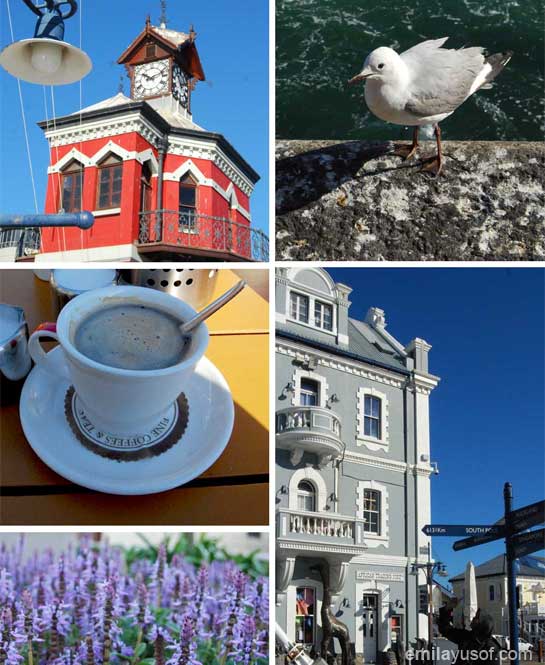
 Table Mountain – Often described as magical and mystical, Table Mountain is Cape Town’s most prominent feature and a world-famous landmark. This mountain is visible from almost everywhere in Cape Town and is often used as a beacon by which to find direction. Table Mountain is home to a rich fauna and flora, many species of which are endemic and survive only in the unique ecosystem which is contained on the mountain. There are about 1,470 species of plants, including over 250 different species of daisies.
Table Mountain – Often described as magical and mystical, Table Mountain is Cape Town’s most prominent feature and a world-famous landmark. This mountain is visible from almost everywhere in Cape Town and is often used as a beacon by which to find direction. Table Mountain is home to a rich fauna and flora, many species of which are endemic and survive only in the unique ecosystem which is contained on the mountain. There are about 1,470 species of plants, including over 250 different species of daisies.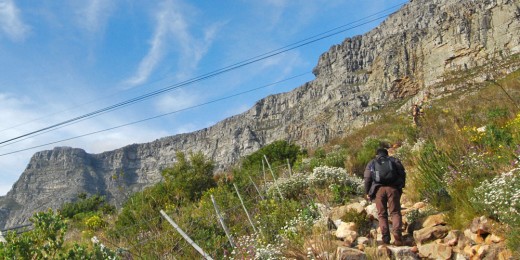
My husband climbing up Table Mountain. Kirstenbosch Gardens – Nestled at the foot of Table Mountain in Cape Town, the gardens boast over 7000 species of plants,125 species of birds, many small and medium-sized mammals, a host of butterflies and insects, amphibians and other reptiles. Open all year round.
Kirstenbosch Gardens – Nestled at the foot of Table Mountain in Cape Town, the gardens boast over 7000 species of plants,125 species of birds, many small and medium-sized mammals, a host of butterflies and insects, amphibians and other reptiles. Open all year round.
 Robben Island – Robben Island is the largest of the islands along the coastline of South Africa. It is 507 hectares, roughly oval-shaped, and about 2 kilometres in length from north to south. From the 17th to the 20th centuries, Robben Island served as a place of banishment, isolation and imprisonment. Today it is a World Heritage Site and museum, a poignant reminder to the newly democratic South Africa of the price paid for freedom.
Robben Island – Robben Island is the largest of the islands along the coastline of South Africa. It is 507 hectares, roughly oval-shaped, and about 2 kilometres in length from north to south. From the 17th to the 20th centuries, Robben Island served as a place of banishment, isolation and imprisonment. Today it is a World Heritage Site and museum, a poignant reminder to the newly democratic South Africa of the price paid for freedom.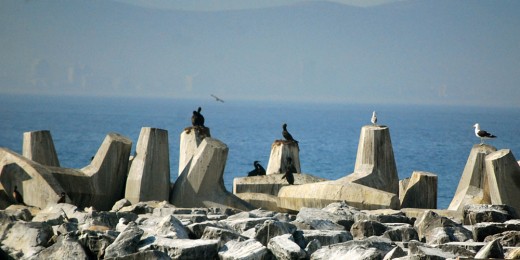
 Cape Point – Cape Point is a promontory at the south-east corner of the Cape Peninsula, which is a mountainous and scenic land-form that runs north-south for about thirty kilometres at the extreme south-western tip of the African continent in the Republic of South Africa. Table Mountain and the city of Cape Town are close to the northern extremity of the same peninsula.
Cape Point – Cape Point is a promontory at the south-east corner of the Cape Peninsula, which is a mountainous and scenic land-form that runs north-south for about thirty kilometres at the extreme south-western tip of the African continent in the Republic of South Africa. Table Mountain and the city of Cape Town are close to the northern extremity of the same peninsula. Constantia Vineyards – Constantia is one of the oldest suburbs of Cape Town and is famed for its wine. The estate of Groot Constantia (Great Constantia) was established in 1684 by the Dutch Colonial Governor of Cape Town, Simon van der Stel. Other notable wine farms in the area include the oldest estate, Steenberg (Mountain of Stone), established in 1682, Buitenverwachting (Beyond Expectations), Klein Constantia (Small Constantia) and Constantia Uitsig (View of Constantia). Before the twentieth century, the region was noted for its exports of Vin De Constance a sweet dessert wine.
Constantia Vineyards – Constantia is one of the oldest suburbs of Cape Town and is famed for its wine. The estate of Groot Constantia (Great Constantia) was established in 1684 by the Dutch Colonial Governor of Cape Town, Simon van der Stel. Other notable wine farms in the area include the oldest estate, Steenberg (Mountain of Stone), established in 1682, Buitenverwachting (Beyond Expectations), Klein Constantia (Small Constantia) and Constantia Uitsig (View of Constantia). Before the twentieth century, the region was noted for its exports of Vin De Constance a sweet dessert wine. -
Cape Town Clock Tower
I am starting a series of buildings I visited and this one will be the first one.

The Clock Tower building from the bridge angle.In 1860, the very first load of stone for the V&A Waterfront’s breakwater was laid. The resulting harbour would become instrumental in establishing a trade route that would turn a small coastal town into a thriving community. It was here, at the water’s edge, that the Clock Tower played host to the Captain’s Office – a vantage point from which he directed the trade that built an entire city. This was the original Port Captain’s Office completed in 1882.
The Victorian clocktower with its Gothic characteristics has always been an icon of the old docks at Table Bay Harbour, Cape Town (now V & A Waterfront) and has become an important focal point in the Waterfront’s recent urban design. Restoration of the Clock Tower was completed towards the end of 1997. The topmost floor housed the clock mechanism, while the bottom floor housed the elaborate tide-gauge operated by a float on the water below. This clock tower is listed as one of the heritage sites in the Cape by the South African Heritage Resource Agency.
The Clock Tower Centre, across the swingbridge from the Pierhead, is the latest addition to the V&A Waterfront’s retail offering. It brings South African crafts, arts, designs and foods together in one centre, along with facilities appealing to tourists and locals alike.
So if you are in Cape Town, do visit this clock tower situated at V & A Waterfront. Here are more pictures from my archive:
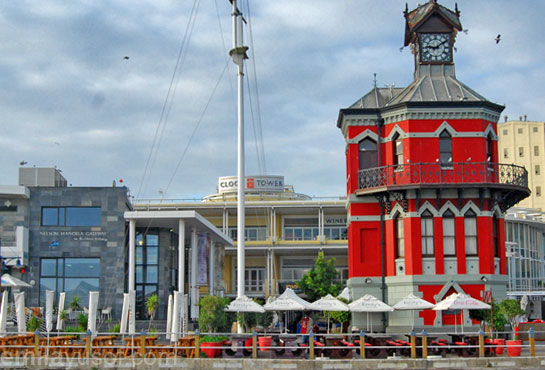
The Clock Tower from across-the-swingbridge angle.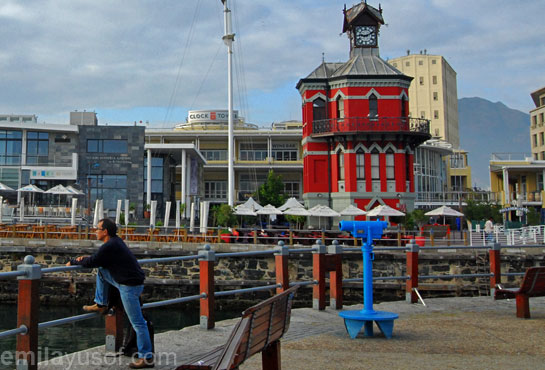
My husband adding to Clock Tower picturesqueness.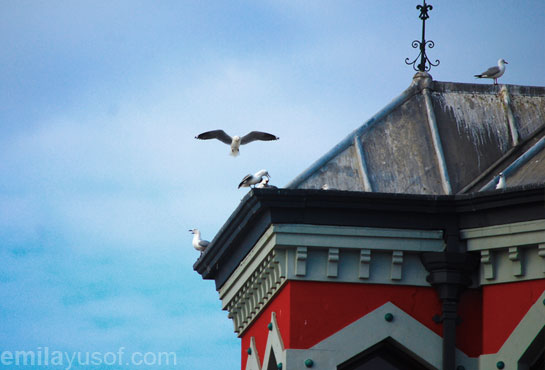
Seagulls like to perch on the roof.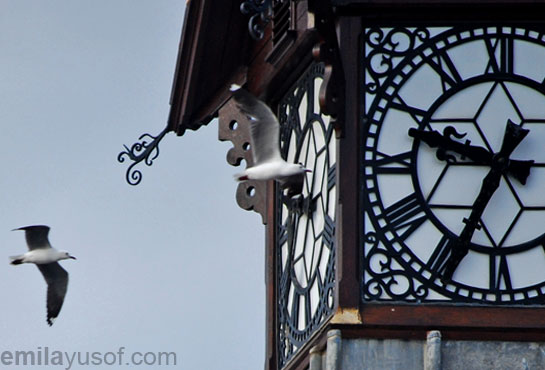
Close-up of the clock, shot using my power lens.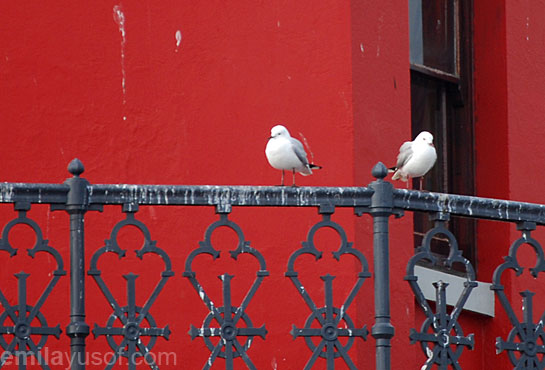
Birds perching on the iron railing at the topmost floor.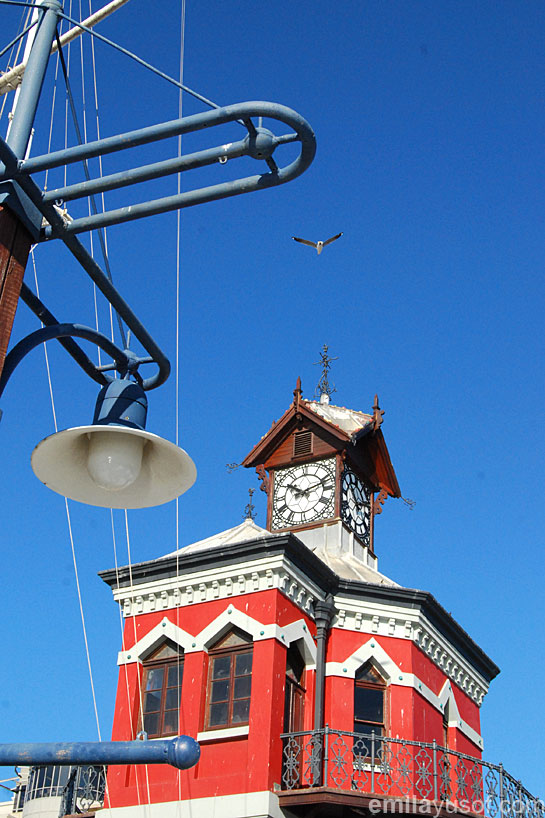
Information about the building:
http://citysightseeing-blog.co.za/2010/05/11/clocktower/
http://en.wikipedia.org/wiki/List_of_heritage_sites_in_the_Cape
http://www.waterfront.co.za/Documents/VA%20Clock%20Tower%20PFB.pdf -
Art & Places: Coca-cola Crateman, Cape Town
If you read my post about the Nobel Peace Prize laureates Statues at V and A Waterfront, Cape Town, you must’ve seen something interesting in the background. Something red.
Well, it caught my eyes too. It was red and gigantic, who could’ve not noticed that. What made it more interesting was the fact that it is made out of Coca-Cola crates. 4,200 crates to be exact, with an inner skeleton of scaffolding and cable ties to hold the structure.
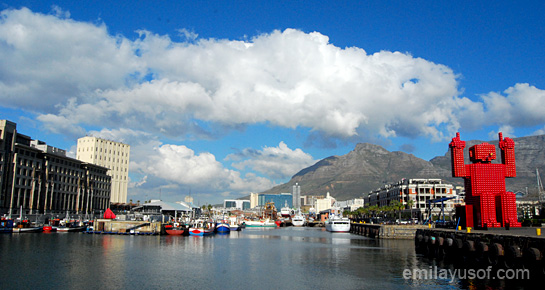
Elliot the crateman, V and A Waterfront, Cape Town, South Africa. July 2011.This giant crateman or cratefan stands 60 feet tall and weighs a whopping 27 tons. It was built by Porky Hefer and his team for Coca-Cola to draw attention to the ever-increasing importance of recycling both cans and plastic bottles. Elliot (named after a foreman of the team who built it) was built for the 2010 FIFA World Cup. According to a signboard there, all materials will be reused or recycled when Elliot is dismantled in 2011. But to verify whether Elliot is still in one piece, I checked with VandAWaterfront on twitter. The person-in-charge told me that Elliot will still be there throughout 2012. Don’t you love social media?!
So, if you travel to Cape Town, don’t miss the chance to ‘say’ hi to him!
-
Art & Places: Nobel Peace Prize Laureates statues, Cape Town
When visiting V & A Waterfront, Cape Town, South Africa, one cannot miss a row of Nobel Peace Prize Laureates statues at the Nobel Square.
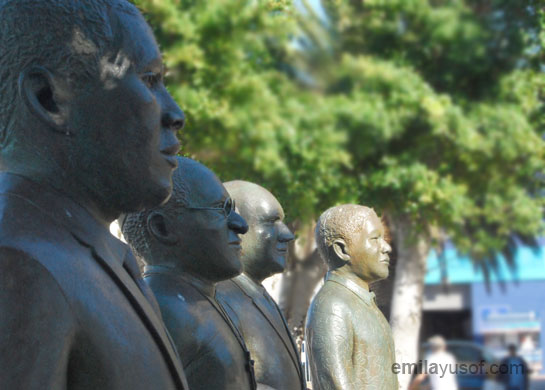
When my husband and I came across these four statues, we were excited to take photos. The four statues are arranged in a neat row for us to pose by, with the added bonus of Table Mountain as a backdrop–a photo opportunity not to be passed up!
The four Laureates are Albert Lithuli (1960), Desmond Tutu (1984), FW de Klerk (1993) and Nelson Mandela (1993). The larger-than-life-sized statues are casted in bronze and were the work of renowned Cape Town artist, Claudette Schreuders. These bronze statues were built to honour South Africa’s four Nobel Peace Prize Laureates for the role they played in achieving peace and democracy.
Nobel Square is situated just beside Waterfront Art Market.
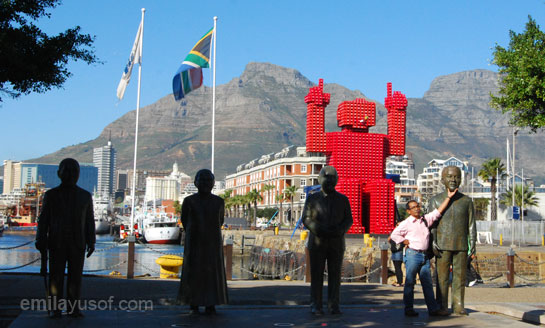
My husband posing with the statues. His favourite is of course, Mr. Mandela. I tell about the giant red crates statue later in another post.
-
Art & Places: Beaded wire art in Cape Town
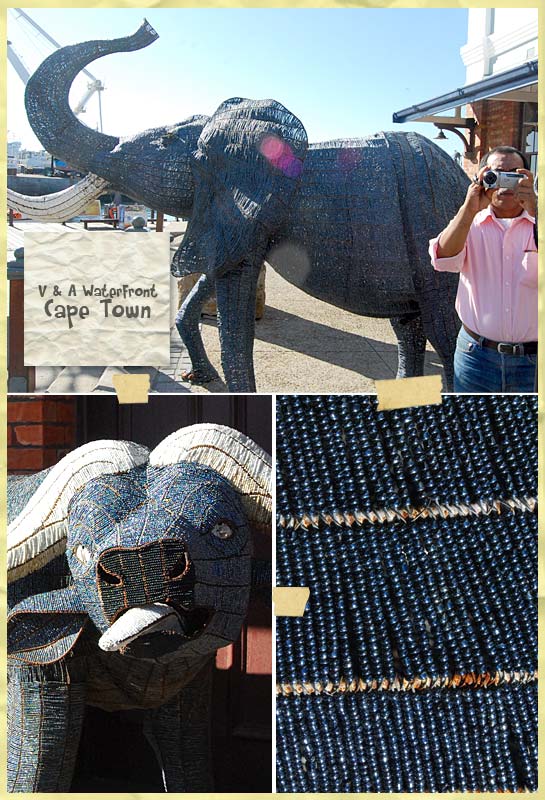
When I visited V and A Waterfront in Cape Town, wire beaded sculptures exhibited outside of the main entrance of African Trading Port captured my eyes. They were huge,very fine and the detailings were magnificent! I wonder how long does it take and how many beads were needed to create one big sculpture. But one thing for sure, this kind of art needs tons of perseverance. It is just amazing that these wire arts are created from wire, beads, tin cans, and other recycled materials. Other than big sculpture like the above, smaller pieces of the wire art in the form of keychains, dolls, decorations, etc, can be found at the Waterfront Craft Market.
According to this website, it is believed that this wire art originated in South Africa’s rural Northern Kwazulu-Natal. Young herd boys were the first to introduce these works of art. Designing wire creations from any recycled materials they could find, these boys produced some of the most magnificent, functioning appliances—they even built cars! Their inspirational wire creations encouraged other locals to participate in this highly marketable art form.
-
Sketchy Sunday: Cape Town Bird
While waiting for the Hop On-Hop Off tour bus near the aquarium at the V and A Waterfront, I noticed a hungry bird and captured it on camera. Kept the photo for my bird study. Here’s a pencil sketch of the bird.
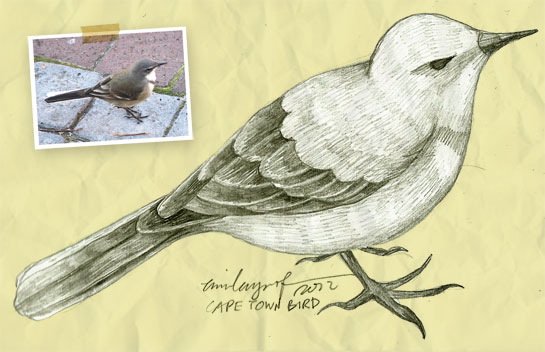
Haha, hell no. Am not in Cape Town now. This was July last year. Do you know what species is this?
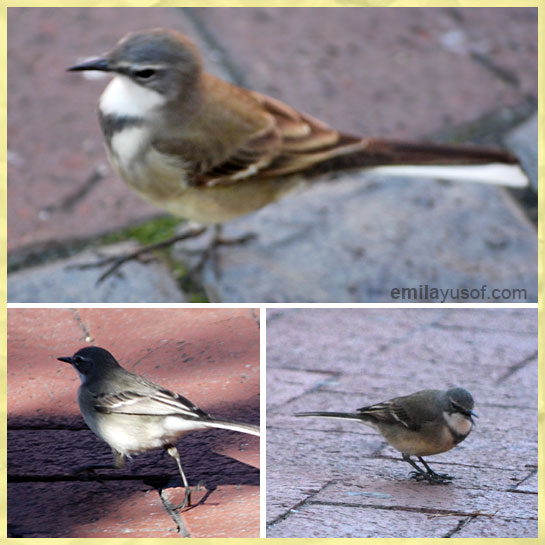
-
Cape Town’s Flat Flowered Mountain Aloe
I like to look back at my photos and among my favourites are those from Kirstenbosch Gardens, Cape Town. The flowers are beautifully breathtaking. One of the flowers I observed was Aloe Marlothii or Flat Flowered Mountain Aloe. I have never seen such a big aloe in my life. The one that I have in my front yard is very small and does not have flowers.
Aloe Marlothii is a striking, robust, large, single-stemmed aloe with a majestic presence. The mountain aloe is undoubtedly one of southern Africa’s most rewarding aloes to grow and adds an interesting slant to aloe culture.
Aloe Marlothii is a succulent and therefore well suited to withstand periods of drought, owing to reserves of water stored in the leaves and stem. The thorns on the leaves and very rough, hard, dried leaves along the stem act as a defence against browsing animals. In times of extreme drought, kudu has been observed browsing the leaves despite the plants’ defences and may denude the leaves of the plant entirely. If conditions are favourable, plants recover within six months. Another defence against browsing is the eventual height obtained by A. Marlothii to escape browsing animals. By growing out of reach of browsers the species has a greater chance of surviving drought.
So, if you are into flowers and aloe species, and will be visiting Cape Town soon, do consider visiting Kirstenbosch Gardens situated at Rhodes Drive, Newlands, Cape Town, South Africa.. It is the largest of a country-wide network of nine National Botanical Gardens administered by the South African National Biodiversity Institute (SANBI).
Operational hours are as follows:
Sep – Mar (Summer): Mon-Sun
08h00 – 19h00Apr – Aug (Winter): Mon – Sun
08h00 – 18h00Conservatory: Mon-Sun
09h00 – 17h00